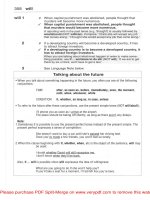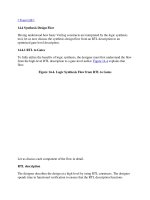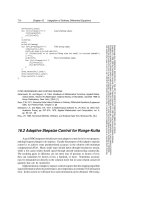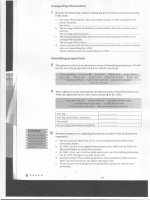Tài liệu Opportunities in technical writing careers part 3 doc
Bạn đang xem bản rút gọn của tài liệu. Xem và tải ngay bản đầy đủ của tài liệu tại đây (94.1 KB, 10 trang )
The new approach, based on nuclear magnetic resonance
(NMR) spectroscopy chemical shifts, is faster and simpler than
conventional NMR methods.
Typically, NMR protein structures are based on interatomic
distances, but these are difficult to measure. On the other hand,
chemical shifts are the most readily obtained and accurate NMR
parameters. They provide information about the molecular envi-
ronment of atoms. They’re used to determine structures of small
molecules, and they’re usually the first thing chemistry undergrads
learn about NMR. . . .
Researchers have wanted to use chemical shifts to determine
protein structures because that sidesteps the need to make time-
consuming nuclear Overhauser effect (NOE) measurements.
NOEs, which are pairwise distances between specific atoms, are
currently the primary basis for most NMR protein structures.
2
The article in example two appeared in Chemical and Engineer-
ing News, a member-supported weekly magazine of the American
Chemical Society. This publication and online resource covers all
the news of the chemical world, including recent advances in
research, industry, education, funding, and regulations. The arti-
cle was written by a staff correspondent who specializes in bio-
chemistry, medicinal chemistry, analytical chemistry, organic
chemistry, and combinatorial chemistry. Those who write for the
magazine must be able to handle highly complex ideas and terms
and still be able to write an interesting story that is easy to under-
stand. The author of this particular article does have one distinct
advantage: most of his readers are chemists. Nevertheless, few of
them will have detailed knowledge about the field of work being
described.
The Field of Technical Writing 11
_______
2. Borman, Stu. “Fast Route to Structures: Technique Defines Protein Structures from
NMR Chemical Shifts.” Chemical and Engineering News 85(23), 6/3/07, p. 10.
Example Three
Some 10,000 years ago, somewhere in the Near East, an audacious
wildcat crept into one of the crude villages of early human set-
tlers, the first to domesticate wheat and barley. There she felt safe
from her many predators in the region, such as hyenas and larger
cats.
The rodents that infested the settlers’ homes and granaries were
sufficient prey. Seeing that she was earning her keep, the settlers
tolerated her, and their children greeted her kittens with delight.
At least five females of the wildcat subspecies known as Felis
silvestris lybica accomplished this delicate transition from forest to
village. And from these five matriarchs all the world’s 600 million
house cats are descended. . . .
Five subspecies of wildcat are distributed across the Old World.
They are known as the European wildcat, the Near Eastern wild-
cat, the Southern African wildcat, the Central Asian wildcat, and
the Chinese desert cat. Their patterns of DNA fall into five clus-
ters. The DNA of all house cats and fancy cats falls within the
Near Eastern wildcat cluster, making clear that this subspecies is
their ancestor. . . .
3
The paragraphs in example three are the beginning of an article
by a scientific reporter and editor who is on the staff of the New
York Times science section. The article goes on to discuss cat DNA
and the animal’s domestication.
You will notice the style of writing in this article is much more
accessible to the lay reader, who does not need to have any partic-
ular training or knowledge to comprehend the topic. The New York
Times, in which this article appeared, is a mainstream publication
12 Opportunities in Technical Writing Careers
_______
3. Wade, Nicholas. “Study Traces Cat’s Ancestry to Middle East.” New York Times,
www.nytimes.com/2007/06/29/science/29cat.html?ref=science, visited 6/29/07.
read by a much more diverse audience than those in the previous
examples. The author of the article clearly understands his reader-
ship and has been able to craft his writing so that, although it
includes technical terms and concepts, it is not so technical as to
be not easily understood by the publication’s average reader.
Example Four
Explore the effects of color mixing with light with this eye catch-
ing demonstration.
The fascinating phenomenon of color mixing is conveyed using
LED technology. A great alternative to traditional ray box and fil-
ters, the ultra bright LEDs of the Color Mixing Apparatus pre-
vent the need for full blackout.
This apparatus is comprised of six large bright LEDs, two each
of red, green, and blue. The brightness of these LEDs can be
adjusted using the control box, and either the inner or outer ring
of lights can be selected, for a full range of experiments. Set the
apparatus in full rotation and use with the included screens to
demonstrate both additive and subtractive color mixing. Using a
blank white screen and the color mixer, you can highlight how
color is perceived; use the black screen with aperture for project-
ing circular patches of light; or use a clear screen with an eclipse
disc for blocking light.
When you use the apparatus in conjunction with the various
screens, you can highlight the way we see color and also how col-
ored light is created. . . .
4
Example four is a product description taken from an online cat-
alog of scientific products. The catalog is intended to take the place
The Field of Technical Writing 13
_______
4. Sargent-Welch Online Catalog, www.sargentwelch.com/product.asp_Q_pn_E_WLS
1751%2D72%5FEA_A_CENCO+Color+Mixing+Apparatus_E_, visited 6/29/07.
of a salesperson by giving prospective buyers a brief, concise, and
accurate description of a scientific apparatus. The catalog must give
potential customers complete information on all its items so that
they will be able to order precisely what they want. The emphasis
in this type of writing is to provide necessary information using a
minimum number of words. For this reason, complete sentences
are not always used.
As you can see from the four preceding examples, the field of
technical writing is broad and can cover preparing articles to go in
everything from a highly specialized journal to a syndicated story
in a large, influential newspaper.
Where to Find Jobs
Chapter 3 will cover the job hunt, helping you to learn what kinds
of jobs are available and how to locate them. But as a starting point,
one of the best ways to get a feel for the various types of work avail-
able to technical writers is to read job advertisements. They often
list the duties and required experience and show you the wide vari-
ety of environments and specializations in which technical writers
work.
You can find job advertisements in any Sunday newspaper or on
the Internet. The Society for Technical Communication has an
active database of job openings in eight different regions in the
United States and Canada. Contact information is provided in the
appendix.
Sample Job Advertisements
Note that the following job announcements do not have contact
information because they have already been filled.
14 Opportunities in Technical Writing Careers
Position: Technical Writer
Job type: Permanent
Company: Technical publications firm
Location: Midwest
Duties: Preparing new and revised information for use in tech-
nical service manuals, user manuals, and operator manuals in the
agricultural and heavy equipment fields. Technical writer will be
responsible for coordinating material from engineers, dealers, and
other sources. Other responsibilities include reading blueprints and
detailed engineering documents, marking up artwork for illustra-
tor, and interacting with engineers, product specialists, and other
technical writers to learn about parts installation and operations.
Requirements: A high school diploma, in addition to voca-
tional, career, or related technical studies in technical writing or
other engineering discipline and one to three years technical writ-
ing experience. An understanding of hydraulic, electrical, and
mechanical systems is required.
Tool skills: Proficient with a personal computer, copier/dupli-
cator, and various software including desktop publishing, spread-
sheet, word processing, illustration, and database programs.
Position: Technical Writer
Job type: Temporary/Contract
Company: A gateway security firm
Location: Southeast
Duties: Researching and writing technical information and
procedures for manuals and online help; developing technical
illustrations and graphics to support written material; editing tech-
nical documentation; and testing documented procedures.
Requirements: Bachelor’s degree and four to six years of
related writing or technical experience; excellent research and writ-
ing skills; background in high-tech industry, preferably with Inter-
net and networking technologies.
Tool skills: Experience with RoboHelp, Word, and HTML
highly desirable.
The Field of Technical Writing 15









